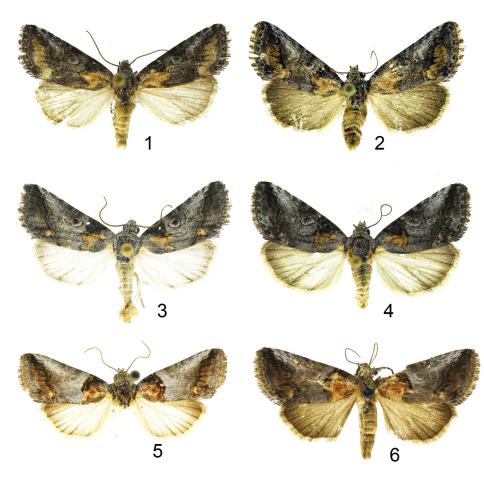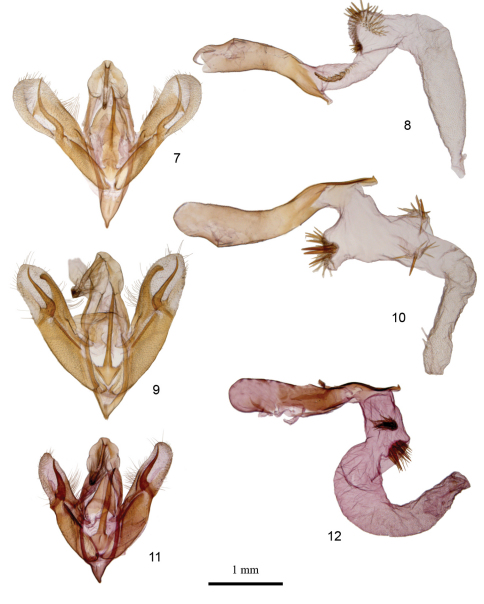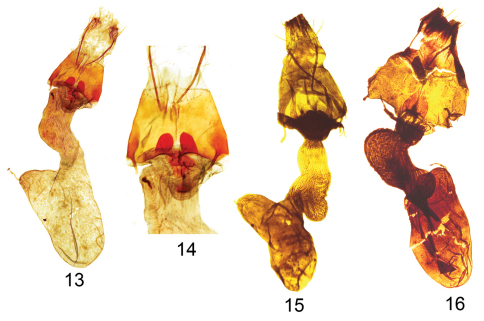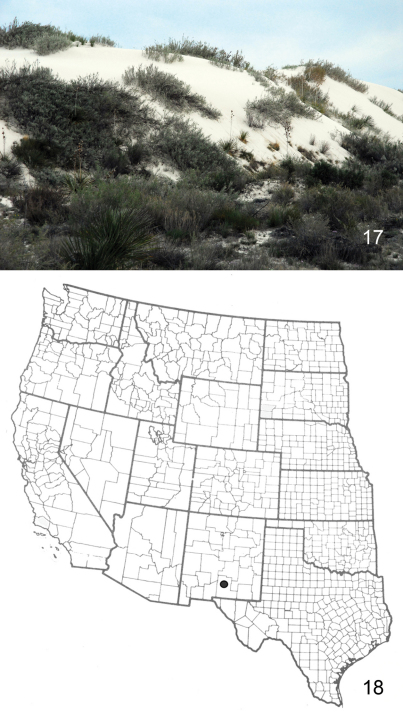Abstract Abstract
In 2006 the US National Park Service initiated a long-term study of the Lepidoptera at White Sands National Monument, Otero County, New Mexico. Aleptina arenaria sp. n., described here, was discovered in 2008, the second year of the study. The adult moths and male and female genitalia are illustrated.
Keywords: Tularosa Basin, biological diversity, white gypsum dunes, Noctuidae, White Sands National Monument, New Mexico, National Park, Otero County
Introduction
The North American genus Aleptina Dyar (1902) was revised by Todd et al. (1984). In 2008, 2009, and 2010, adults of an unknown species of Aleptina were collected at White Sands National Monument, New Mexico. No specimens of this species were known prior to this study of insects at the Monument. The lack of specimens can probably be attributed to a dearth of collecting in the gypsum dunes ecosystem of White Sands National Monument in New Mexico, which is under the jurisdiction of the U.S. National Park Service and the U.S. Army’s White Sands Missile Range.
Methods
More than 250 samples of moths and other night flying insects were collected in U.S.D.A. type black light traps, and at black light, as described in Covell (1984), sometimes with mercury vapor light, and sheet on more than 75 different nights. A detailed description of the study methods is in Metzler et al. (2009). Genitalia were examined following procedures outlined in Metzler and Forbes (2011). Terminology for elements of wing pattern, morphology, and genital structures follows Todd et al. (1984), Lafontaine (2004), and Mikkola et al. (2009).
All specimens were collected as part of a long-term study of Lepidoptera at White Sands National Monument, and they are deposited in the following collections:
EHM
MSU
UNM
USNM
Results
Aleptina arenaria
Metzler & Forbes, sp. n.
urn:lsid:zoobank.org:act:B2D5BDEB-3743-4C92-87EE-9899390FA809
http://species-id.net/wiki/Aleptina_arenaria
Figs 1, 2 11, 12 13, 14 17, 18
Figures 1–6. Aleptina adults. 1 Aleptina arenaria Metzler & Forbes, male holotype 2 Aleptina arenaria Metzler & Forbes, female paratype 3 Aleptina inca Dyar, male 4 Aleptina inca Dyar, female 5 Aleptina clinopetes Dyar, male 6 Aleptina clinopetes Dyar, female.
Figures 7–12. Aleptina male genitalia. 7 Aleptina inca Dyar, male genital details 8 Aleptina inca Dyar, male genital details of aedeagus 9 Aleptina clinopetes Dyar, male genital details 10 Aleptina clinopetes Dyar, male genital details of aedeagus 11 Aleptina arenaria Metzler & Forbes, male genital details, paratype 12 Aleptina arenaria Metzler & Forbes, male genital details of aedeagus. paratype.
Figures 13–16. Aleptina female genitalia. 13 Aleptina arenaria Metzler & Forbes, female genital details. paratype 14 Aleptina arenaria Metzler & Forbes, female genital details of two eighth sternite processes. paratype 15 Aleptina inca Dyar, female genital details 16 Aleptina clinopetes Dyar, female genital details.
Figures 17–18. Aleptinaarenaria habitat and distribution map. 17 White dunes habitat of type locality of Aleptina arenaria 18 Distribution map for Aleptina arenaria.
Type Material.
Holotype: male, pinned with labels as follows: “USA: NM: Otero Co. White Sands Nat[ional] Mon[ument], interdune habitat, 106°10.84'W, 32°46.64'N 4,008', 17 May 2010 WsnmF, Eric H. Metzler, uv tr[a]p, Accss #: WHSA - 00131" “HOLOTYPE USNM Aleptina arenaria Metzler & Forbes” [red handwritten label] (USNM). Paratypes: 5 males and 7 females: USA: NM: Otero Co. White Sands Nat[ional] Mon[ument] (hereafter WSNM), interdune habitat, 106°11.38'W, 32°46.69'N 4,000', 15 July 2009 WSNM8, Eric H. Metzler, uv tr[a]p, Accss #: WHSA - 00131. USA: NM: Otero Co. WSNM, interdune habitat, 106°10.84'W, 32°46.64'N 4,008’, 12 Sept. 2010 WSNMF, Eric H. Metzler, uv tr[a]p, Accss #: WHSA – 00131. WSNM, interdune habitat, 106°11.38'W, 32°46.69'N 4,000', 11 June 2010 WSNM8, Eric H. Metzler, uv tr[a]p, Accss #: WHSA - 00131. WSNM, interdune habitat, 106°11.32'W, 32°45.72'N 4,000', 22 July 2008 WSNM9, Eric H. Metzler, uv tr[a]p, Accss #: WHSA - 00131. WSNM, interdune habitat, 106°11.32'W, 32°45.72'N 4,000', 17 May 2010 WSNM9, Eric H. Metzler, uv tr[a]p, Accss #: WHSA - 00131. WSNM, interdune habitat, 106°10.84'W, 32°46.64'N 4,008', 14 Sept 2009 WsnmF, Eric H. Metzler, uv tr[a]p, Accss #: WHSA - 00131. WSNM, interdune habitat, 106°10.82'W, 32°46.62'N 4,008', 15 July 2009 WSNMD, Eric H. Metzler, uv tr[a]p, Accss #: WHSA - 00131. Paratypes are deposited with UNM, MSU and EHM.
Etymology.
Gypsum sand is the substrate of the white dune field at White Sands National Monument. Arena means sand in Latin. The Latin suffix -aria means connected with something. The specific epithet of this species, arenaria, a singular adjective, calls attention to the specialized sandy habitat where Aleptina arenaria was discovered.
Diagnosis.
Aleptina arenaria (Figs 1, 2) is a gray moth with normal noctuid transverse markings and spots. The diagnostic features are 1) male with gray hindwings, 2) antemedial and subterminal areas of the forewing are pale tan (chamois colored), 3) smoothly rounded apex of the male valve without process (Fig. 11), and 4) blunt posteriorly directed processes on female 8th sternite (Figs 13, 14). In White Sands National Monument Aleptina arenaria flies with and might be mistaken for a washed-out specimen of Aleptina inca Dyar, 1913 (Figs 3, 4).The male hind wing of Aleptina inca is white, the male hindwing of Aleptina arenaria is gray. The clasper of the male genitalia of Aleptina inca (Fig. 7) is half the length of the valve and slender; the clasper of Aleptina arenaria is shorter and heavier, more like that of Aleptina clinopetes (Dyar, 1920) (Figs 5, 6, 9). The costal margin at the distal end of the valve of Aleptina clinopetes (Fig. 9) has a finger-like process; the costal margin at the distal end of the valve of Aleptina arenaria is without a process. The posteriorly directed processes of the female 8th sternite of Aleptina inca (Fig. 15) are thin, long, and pointed; the processes of Aleptina arenaria are stout and short. In Aleptina clinopetes, the processes are stout and longer (Fig. 16). In the key to species in Todd et al. (1984), Aleptina arenaria keys to Aleptina inca in couplet 1 because both species have the front (frons) produced into a shelf-like prominence. The differences noted above will separate Aleptina arenaria, Aleptina inca, and Aleptina clinopetes.
Description.
Adult male (Fig. 1). Head - frons produced into a shelf, gray dorsad, pale tan (chamois colored) between the shelf and clypeus; vertex scales narrow strap-like, gray; labial palpus erect, scales spatulate, black laterally and dorsally, white ventrally, each segment pale tipped. Haustellum coiled between labial palpi. Antenna filiform, dorsally pale gray, closely scaled, ventrally naked, gray. Thorax - dorsum gray, mixture of pale and dark, scales spatulate; underside dirty white, scales erect long hair-like. Legs dark gray, closely scaled, sparse long hair-like whitish scales; tarsomeres dark gray and black, white tipped. Fore wing: Length 10 mm (no variation, n = 4). Gray with pale tan (chamois colored) in antemedial and subterminal areas. Basal line obscure, basal area pale gray; antemedial line double at costa, single at inner margin, antemedial area pale tan; postmedial line obscure, excurved beyond reniform, highlighted with dark dashes on veins, double at inner margin; subterminal line a white shade, postmedial area pale tan; terminal line black, subterminal area gray; orbicular spot a round black and white ring filled with gray; reniform spot a kidney shaped black and white ring filled with gray; costa at postmedial area pale gray; fringe gray with white bars; underside gray, darker along costal and terminal areas; fringe dark gray. Hind wing pale gray, darker in terminal areas, fringe pale gray; underside pale gray, costa darker, fringe pale gray. Abdomen - dorsum closely scaled, pale tan-gray; underside closely scaled, whitish. Genitalia (Fig. 11) - tegumen expanded laterally, bilobed, uncus nearly straight, lightly setose, terminally produced to a small bulb, three stout dorsal setae; saccus short, narrowly V-shaped; juxta with long thin spine pointed anteriorly; valve strap-like, sacculus sclerotized, well developed, costa undulating, sclerotized basal 2/3 length, cucullus membranous, corona not developed, clasper sinuous, 1/3 length of valve, stout at base, produced to a point. Aedeagus (Fig. 12) sinuous, sclerotized, apex with thin blunt point, vesica with two patches of thin setae.
Adult female (Fig. 2): similar to male. Forewing length 10 mm, no variation, n = 7. Genitalia (Figs 13, 14): Papilla analis not sclerotized, setose; posterior apophysis extends anteriorly to mid-point of eighth segment; anterior apophysis short and stout; eighth segment anterior ventral margin with two posteriorly directed processes, broadly rounded, acute apices; ductus bursae sclerotized at extreme posterior end, else membranous, elongate directed to right; corpus bursae expanded to left, signa absent.
Remarks.
This new species is placed in the genus Aleptina Dyar (1902) based on appearance of the adult and the structure of the male and female genitalia.
Distribution and biology.
Aleptina arenaria occurs in White Sands National Monument, Otero County, New Mexico (Figs 17, 18). Adults were collected in black light traps placed within the white gypsum dunes, and interdunal areas. The immature stages and larval host plants are unknown.
Discussion
In 2006 the U.S. National Park Service invited Metzler to initiate a long-term study of the Lepidoptera at White Sands National Monument, Otero County, New Mexico. A primary purpose of the study was to compile an inventory of moths in habitats within and immediately adjacent to the white gypsum dunes in the Monument.
White Sands National Monument preserves 285 km2 (110 mi2), or about 40%, of the world’s largest snow-white gypsum dune field. The remainder of the 275 square miles dune field is under the jurisdiction of the U.S. Army in the White Sands Missile Range. The dune field is located in the northern Chihuahuan Desert in southern New Mexico’s Tularosa Basin (Schneider–Hector 1993). A complete description of the study site and some of its unique biological resources is in Metzler et al. (2009).
There is a dearth of research on the invertebrate fauna in the gypsum dune field in the Tularosa Basin of New Mexico. Details of previous research pertinent to insects is in Metzler et al. (2009).
In the period 9 February 2007 through 30 September 2010 Metzler and Forbes identified more than 430 species of Lepidoptera (unpublished data) from the Monument. Because of the unusual physical and biological qualities of the New Mexico white gypsum dunes, we were especially aware of the possibility of finding undescribed species of moths. This is the fifth (Metzler et al. 2009, Metzler et al. 2010a, Metzler et al. 2010b, Metzler and Forbes 2011) in a series of papers pertinent to a detailed study of the Lepidoptera at White Sands National Monument, and this is the third species of moth described as part of this study. The study of Lepidoptera at White Sands National Monument by Metzler and Forbes is projected to last approximately 10 years.
Supplementary Material
Acknowledgments
The Western National Parks Association, Tucson, Arizona contributed funding for travel for this study of Lepidoptera at White Sands National Monument. We are grateful for their financial support.
Several persons, Hildy Reiser, Diane White, Cliff Spencer, and Kevin R. Schneider, from the U.S. National Park Service were instrumental in arranging and promoting this study of the moths at White Sands National Monument. We especially thank David Bustos from White Sands National Monument for his assistance and support of our research. The National Park Service renewed the study for 2007 through 2010. Representatives from research collections provided insect pins, alcohol, identification services, research consultation, and storage space for specimens collected. We thank the following persons for offering support from their respective institutions: David B. Richman (NMSU) Kelly B. Miller, Sandra L. Brantley, and David C. Lightfoot (UNM), Frederick W. Stehr, Anthony I. Cognato, and Gary L. Parsons (MSU), Charles V. Covell, Jr., University of Florida, Gainesville FL, J. Donald Lafontaine, Canadian National Collection, Ottawa ON, Larry Berger Ohio Department of Agriculture, and David G. Furth (USNM). Patricia A. Metzler faithfully assisted Metzler in many aspects of this study. We thank Sandra Brantley, Frederick W. Stehr, and two anonymous reviewers for reading the paper and offering valuable suggestions. Don Lafontaine assisted with dissections of male genitalia, and Jocelyn Gill assisted with layout of the color illustrations.
References
- Covell CV Jr. (1984) A Field Guide to Moths of Eastern North America. Virginia Museum of Natural History Special Publication Number 12. Martinsville, Virginia, 496 pp. [Google Scholar]
- Dyar HG. (1902) Description of a new noctuid. The Canadian Entomologist 34: 105. 10.4039/Ent34105a-4 [DOI]
- Dyar HG. (1920) New Lepidoptera, chiefly from Mexico, with synonymic notes. Insecutor Inscitiae Menstruus 8: 187-198. [Google Scholar]
- Lafontaine JD. (2004) The Moths of North America Including Greenland, Fascicle 27.1, Noctuoidea Noctuidae (part) Noctuinae (part - Agrotini). The Wedge Entomological Research Foundation, Washington, DC, 385 pp. [Google Scholar]
- Metzler EH, Bustos D, Forbes GS. (2009) The Lepidoptera of White Sands National Monument, Otero County, New Mexico, USA 1.Two new species of Noctuidae (Lepidoptera, Noctuinae, Agrotini). ZooKeys 9: 47-62. doi: 10:3897/zookeys.9.182. [Google Scholar]
- Metzler EH, Forbes GS, Bustos D. (2010a) Moth Studies at White Sands National Monument. In: Greenwald David H (Ed) A Walk Through Time - The Tularosa Basin’s Past, 2009 Tularosa Basin Conference Proceedings. CD-ROM.
- Metzler EH, Forbes GS, Bustos D, West R. (2010b) First records, representing major range extensions, of three species of Lepidoptera (Erebidae, Noctuidae, and Lasiocampidae) from New Mexico. Southwestern Entomologist 35: 309-311. 10.3958/059.035.0309 [DOI] [Google Scholar]
- Metzler EH, Forbes GS. (2011) The Lepidoptera of White Sands National Monument, Otero County, New Mexico, USA 2. Rediscovery and description of Sparkia immacula (Grote, 1883) (Noctuidae, Noctuinae, Hadenini). In: Schmidt BC, Lafontaine JD. (Eds). Contributions to the systematics of New World macro-moths III. ZooKeys 149: 117–123. 10.3897/zookeys.149.1516 [DOI] [PMC free article] [PubMed]
- Mikkola K, Lafontaine JD, Gill JD. (2009) The Moths of North America including Greenland Fascicle 26.9 Noctuoidea Noctuidae (part) Xyleninae (part) Apameini (part – Apamea group of genera). The Wedge Entomological Research Foundation, Washington, DC, 192 pp. [Google Scholar]
- Schneider–Hector D. (1993) White Sands The History of a National Monument. The University of New Mexico Press. Albuquerque, New Mexico, 270 pp. [Google Scholar]
- Todd EL, Blanchard A, Poole RW. (1984) A revision of the genus Aleptina (Lepidoptera: Noctuidae). Proceedings of the Entomological Society of Washington 86 (4): 951-960. [Google Scholar]
Associated Data
This section collects any data citations, data availability statements, or supplementary materials included in this article.






